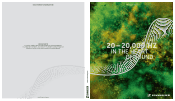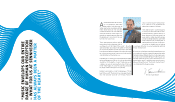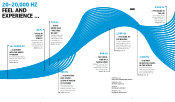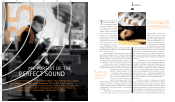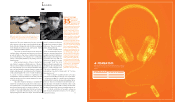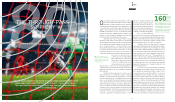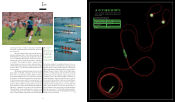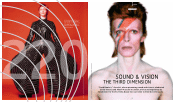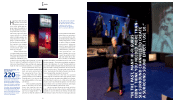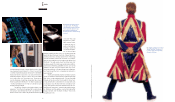Sennheiser 2012 Annual Report Download - page 6
Download and view the complete annual report
Please find page 6 of the 2012 Sennheiser annual report below. You can navigate through the pages in the report by either clicking on the pages listed below, or by using the keyword search tool below to find specific information within the annual report.
10
20–20,000 Hz
j MOMENTUM
With the finest leather and a powerful sound even on the go
– the new luxury headphones from Sennheiser make quality
tangible
Sennheiser MOMENTUM A work of art from the Style Selection
Frequency response 16–22,000 Hz (-3 dB)
Transducer principle dynamic, closed
Total harmonic distortion 1 kHz ≤ 0.5%
Weight 190 g
ESSAY
the bass bar. The vocal formants from 700 up to 1,000 Hz,
which give the violin its open sound. And, finally, all the is-
lands of vibration that give the violin its brilliance swimming
in the frequencies between 2,000 and 3,000 Hz. Finally,
what was hidden had been revealed.
The longer I worked along these lines, the more I
realized I didn’t really understand the theoretical back-
ground. Left with no other choice, I completed a baccalaure-
ate and studied physics. My only purpose: to continue my
pursuit of the mystery behind a good, healing sound. It’s
what drives me.
After I received a master of physics, I had my first
opportunity to experience a Stradivarius, one of the most
famous violins of all times, first-hand in the intimate acous-
tics of my new studio. As soon as the bow struck the string,
the room was filled with a warmth, a breath, a volume and
radiance palpable even to an untrained ear. The Stradivarius
is like a prayer dipped in the colors of sound. It’s like being
in a cloud of sound, a combination of gentleness and
strength that is downright addictive. It was this violin that
made me decide to become a teacher during my first years
as a master violinmaker.
The violins of Guarneri del Gesù are completely dif-
ferent from a Stradivarius. Basically, its two main resonanc-
es are further part. You can feel how the tones are kneaded
and formed under the arch, positively sucking it in. The
sounds are like freshly fallen snow that has been tamped
underfoot – especially on the G string. It is a rich, crisp, sat-
isfying feeling. Dense, dark and compact. And lower down
on the E-string, these violins have
a reddish tone covered in a silvery
iridescence. They can be almost
archaic, hissing and large.
I’d been studying these
violins for decades when, about a
year ago, I had the feeling I had
reached some kind of destination.
When master violinist Ingolf Tur-
ban visited me at my studio, he
fell head over heels in love with
my youngest “child”: the Violin
Opus 130. Despite owning his own
Stradivarius, he now performs all
his solo concerts using my violin.
“This violin is X-rated,” he once
said, winking at me. But his thanks said it all: “You have
given me my voice!”
Even so, I haven’t reached my final stop. For years
now, I’ve been researching a novel type of resonance vibrato
– a frequency modulation of the resonances themselves,
something that to date has only been achievable by the hu-
man voice. There is no instrument in the world able to pro-
duce these types of modulations in which an oscillator, such
as a vibrating string, “plays” with a sound board. The result
would be monumental, producing a sound like never before.
I’m afraid one lifetime isn’t enough to achieve my
goals of beauty and perfection. Even so, it’s not going to
stop me from trying.
TUNING THE TONE
35
Hz is how much
luthier Martin
Schleske was off the
mark when he tried
to recreate a Stradivarius violin in
1999. Germany’s most famous violin
manufacturer designed an instru-
ment whose “spectral center of
gravity” of 1,276 Hz was only very
slightly above that of the old mas-
terpiece (1,241 Hz). Using physics,
Schleske wants to achieve some-
thing no one else has ever been able
to do: to surpass the classic Stradi-
varius and del Gesù. No wonder
Schleske is considered the “most in-
formed and scientifically active lu-
thier in the world” by a few Harvard
professors. Schleske began studying
the violin with Hungarian Attila
Balogh, a soloist at the Berlin Phil-
harmonic. Later, he learned the art
of violinmaking in the Bavarian vil-
lage of Mittenwald, a center of in-
strument-making. Today, world-re-
nowned soloists such as Jehi Bahk
and Ingolf Turban play his instru-
ments. Schleske has a studio and
sound laboratory at Gut Grubmühl
near Munich, where he uses the new,
leather-covered, luxury headphones
from Sennheiser – the MOMENTUM.
His book “The Sound: From the
Incredible Sense of Life” was
published in 2010 by Kösel Verlag.
c1. Corpus delicti: In the heart of the violin, Schleske is con-
ducting research into the right resonances. b2. Work ac-
complished: “An individual acoustic and visual sculpture”

